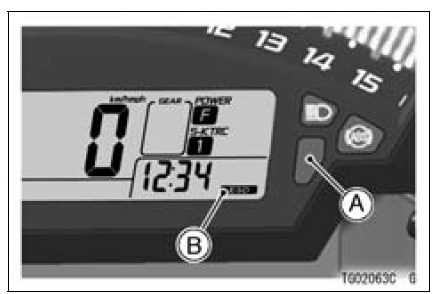

The yellow light functions as the electronic steering damper warning indicator.
The light and warning symbol "ESD" go on if there is a malfunction in the electronic steering damper system.
However, this could also be caused by trouble with the charging system (e.g.
battery). If the warning light comes on, check the battery to be sure it is fully charged. If the battery is fully charged and the warning light still goes on, have the electronic steering damper system checked by an authorized Kawasaki dealer.
The electronic steering damper system maintains the last damping force setting if it fails.

A. Yellow Warning Indicator Light
B. Electronic Steering Damper Warning Symbol
 KIBS Warning Indicator Light (For models equipped
with KIBS)
KIBS Warning Indicator Light (For models equipped
with KIBS) ABS Indicator Light (For models equipped with KIBS)
ABS Indicator Light (For models equipped with KIBS)Exhaust Butterfly Valve Actuator Inspection
NOTE
Be sure the battery is fully charged
Remove the front seat (see Front Seat Removal in the
Frame chapter).
Turn the ignition switch to ON.
In the left side view of the motorcycle, check to see
the pulley [A] clockwise [B] and counterclockwise [C]
smoothly.
The pulley turns ...
Special Tools
Fork Oil Level Gauge:
57001-1290
Vacuum Gauge:
57001-1369
Hand Tester:
57001-1394
Throttle Sensor Setting Adapter #1:
57001-1400
Peak Voltage Adapter:
57001-1415
Needle Adapter Set:
57001-1457
Throttle Sensor Setting Adapter:
57001-1538
Measuring Adapter:
57001-1700
...
Piston Ring, Piston Ring Groove Wear Inspection
Check for uneven groove wear by inspecting the ring seating.
The rings should fit perfectly parallel to groove surfaces.
If not, replace the piston and all the piston rings.
With the piston rings in their grooves, make several measurements
with a thickness gauge [A] to determine pisto ...